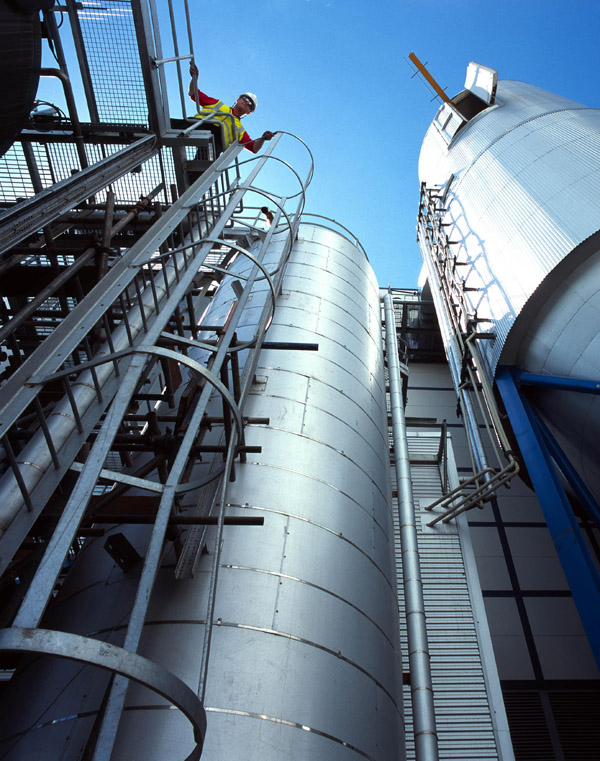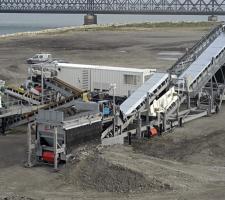
Incineration of refuse in place of landfilling is gaining acceptance in Europe but the process creates waste in the form of slag. ABE takes a look at the French approach to turning slag into aggregates
Growing environmental concerns and lack of potential sites means that landfilling is no longer the easy option for disposing of domestic waste in Europe. The alternative is incineration which not only offers the opportunity for power generation but the residues - known as slags - can also be reused.
France has 130 incinerator sites producing around 3million tonnes of incinerator slags each year and over 75% of this material is reused in road construction. According to
"Communities are not always keen to have a new refuse incinerator built in their town but nobody wants refuse landfilled either," said Azran. "But the waste needs to be disposed of somehow and incineration creates a by-product with some commercial value." In France, certain incinerator slags can be reused in road construction - not in the binder or surface course but as a fill material in the lower layers or as trench backfill. In addition to the practicality of the material, there are also significant savings to be made with an average price of €5 per tonne of treated slag compared to €11 per tonne for gravel.
"In France, incinerator slags are divided into three types under regulations laid down by the French Ministry of the Environment in 1994," explained Azan. "The groups are based on the chemical composition of the material." S-class - standing for storable - is the most polluting material and contains heavy metals. This material cannot be reused on the French highway system and must be stockpiled in a protected area before disposal under controlled conditions.
M- class - maturable materials - are less polluting than S-class and must be left to age before they are treated for reuse. The maturing process can last up to a couple of weeks and is designed to allow chemical reactions within the material to take place and the material to stabilise. To be classified as M-class, contaminants must not exceed specific levels.
The final group is V-class - valourisable materials - and materials in this group can be taken straight from incineration to the aggregate processing stage.
Azran estimates that out of the 3million tonnes of incinerator slags produced in France last year, around 600,000tonnes fell into the S-class, just over 1.9million tonnes were classified as M-class and the remaining volume was then classed as V-class.
"Once the incinerator slag has been classified, it can be processed for reuse," said Azran. "The M-class materials need specific treatment.
"The first process is to crush and screen the material to provide grading control - the ideal size range is 0 to 31.5mm.
To achieve this, the material is passed through a series of grizzly grids, crushers and screens that are specifically designed for processing slags." The crushing and screening phase is followed by a refining process to remove the unburned material such as paper and plastics. "The system uses blowers to extract the lighter, unburned material," said Azran. "For use in road construction in France, the slag must have less than 5% of unburned material." The processed material is then passed through a series of magnets to remove any ferrous material that remains in the slag. Any non-ferrous material is removed by passing an EDDY current through the material. "Removal of the ferrous material improves the slag's quality but with the current high metal prices, the ability to sell off the ferrous material provides a separate revenue stream," said Azran.
Slag processing plants generally have a capacity of 100tonnes per hour and are designed to be 'mobile' making it possible to move the plant to the incinerator site and relocate it three or four times per year.
Once processed the material is ready for re-use but only in specific layers of the road. "There are two main reasons why the slag cannot be used in every layer of the asphalt and it is not suitable for every site," explained Azran. "In France the slag cannot be used near a natural source of water or groundwater because of the potential for leaching of any pollutants in the slag.
"Also the slag cannot be placed next to the bitumen layers because there is potential for chemical reaction between the bitumen and slag which can cause expansion and spalling. The slag is best used in intermediate layers with 100 to 150mm of cement gravel or natural gravel between the slag and the bituminous layers.
"Another common use for the processed slag is for the back filling of trenches, particularly around waste pipes." Currently nearly all the available incinerator slag is reused in France but, despite the proven processing technology, there is still reluctance for wider uptake of the material, according to Azran. "Cities in France are not keen to use incinerator slags as they fear pollution," he said. "It is a good way to recycle waste but acceptance of the technique varies across the country, with the decision to use or not to use very much dependant on the environmental stance of the local mayor."
Growth Pressure on land use in France is likely to drive development of more incinerators for disposal of domestic waste over the next 20 to 30 years, so there is potential for the slag market to grow in line. "Production of domestic waste is
forecast to continue rising in France and there is a real lack of new landfill space," said Azran. "Here we have had a policy to recycle before landfilling or incinerating where ever possible since 2002, but the level of slag production is still likely to continue rising as not all waste can be recycled.
"The incinerator slag market is currently very small compared to the overall aggregates market - just a drop in the ocean. But if more incinerators are built to cope with rising levels of waste, then the amount of slag available will also rise and there is potential for slags to replace more virgin aggregate.
"France's annual aggregate consumption is 400million tonnes, so the current level of incinerator slag recycling represents less than 1% of the total volume. But in terms of reducing the volume of refuse sent to landfill, incinerator slags have a significant part to play not just in France, but also in the rest of Europe." n
in terms of reducing the volume of refuse sent to landfill, incinerator slags have a significant part to play not just in France, but also in the rest of Europe
| INCINERATOR SLAG CLASSIFICATION | |||
|---|---|---|---|
| Pollutants | Class V (Calorisables) |
Class M (Maturables) |
Class S (Storables) |
| Unburned Materials Remaining | <5% | < 5% | > 5% |
| Soluble | <5% | <10% | >10% |
| Mercury (MG/KG) | <0.2 | <0.4 | >0.4 |
| Lead (MG/KG) | <10 | <50 | >50 |
| Cadmium (MG/KG) | <1 | <2 | >2 |
| Arsenic (MG/KG) | <2 | <4 | >4 |
| Chromium (MG/KG) | <1.5 | <3 | >3 |
| Sulfates (MG/KG) | <10,000 | <15,000 | >15,000 |
| Total Organic Carbon (MG/KG) | <1,500 | <2,000 | >2,000 |














